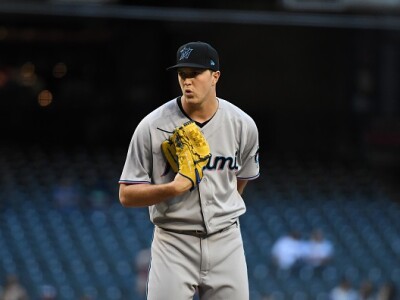Despite a very good debut in 2020, it feels like the fantasy community overlooked Miami southpaw, Trevor Rogers. Through 12 starts he's 6-3 over 68.2 innings with an 81:24 K:BB, 1.97 ERA, 3.55 SIERA and 1.09 WHIP. Among rookie pitchers, he leads in wins, ERA and strikeouts while ranking fifth in the majors in ERA. He's the first Marlins pitcher with at least 80 strikeouts and an ERA below two over his first 12 starts in a season. Pretty, pretty, pretty good.
As the two-time defending rookie of the month in the National League, Rogers owns a 29.7 strikeout percentage with an 8.8 walk rate. He’s recorded a 14.6 swinging strike percentage with 70.4 contact rate allowed, an 80.3 Z-Contact (in the strike zone) percentage and 33.2 O-Swing (outside the strike zone) percent. These represent improvements compared to his small sample size from 2020.
Rogers mostly uses three pitches against hitters. He's throwing more four-seam fastballs and change-ups this year while using fewer sliders with tremendous success. Check out his swing and miss chart from Statcast illustrating how he attacks hitters:
Parsing out his numbers by pitch yields more information of interest to fantasy players including mining his swinging strike percentage by pitch on Brooks Baseball:
| Pitch | Usage% | Whiff% | PutAway% | K% | SwStr% |
| 4-seam FB | 59.4% | 27.9% | 26.8% | 30.5% | 13.4% |
| Change | 25.3% | 32.9% | 23.1% | 28.9% | 20.4% |
| Slider | 15.2% | 45.9% | 20.8% | 22.7% | 17.8% |
Like many pitchers in this era, Rogers uses elevated fastballs to unlock swinging strikes at or below the bottom third of the strike zone. Producing weak batted ball events also fuels his success. He's allowed 165 batted ball events this year giving up seven barrels (4.2 percent) and a 38.2 hard hit rate against.
Although he's generating fewer ground balls (41.8 percent versus 46.1 in 2020), he remains successful by lowering his line drives allowed by almost five percent with weak flyouts in a ballpark made for pitchers in Miami. Through 68.2 innings this year, he's only given up three home runs.
His expected numbers correlate well with this data. He owns a 2.97 expected ERA (xERA) with a .211 expected batting average against, .327 expected slugging, a .267 weighted on-base average (wOBA) versus a .275 expected weighted on-base average. Rogers ability to keep the ball down while avoiding the center of the strike zone insulates his results to this point:
Despite increasing his zone percentage by two percentage points this year and a rise in zone swing percentage by 6.7 percent, he's reduced zone contact by 3.3 percent. Rogers also upped his swing percentage against this season while also growing his whiff rate by 1.6 percentage points. Attacking in the strike zone more while garnering more whiffs once again suggests his breakout rates as sustainable.
One cannot predict injury or regression. There's going to come a point he fatigues due to the limited exposure to the majors last year. Still, armed with an arsenal with an uptick in velocity this season, he's overcome any early struggles with a strong season. His xERA and SIERA set a nice bridge of predictive outcomes with a bit of migration to the mean but not a collapse. Especially given his home pitching environment.
Statcast uses swing and take charts to quantify a pitcher's ability to depress run production. So a negative score in this sample rates well. Here's his chart for 2021:
Rogers excels in the heart of the strike zone and the shadow region as exemplified by the chart. Seeing a young pitcher with his skill set take the necessary steps forward in his progression culminates in a breakout season. There may be some bumps in the road in the months ahead or his workload may be managed near the All-Star break, but his ability to produce results with strong underlying data supporting them makes him a pitcher to remember in 2022 drafts.
For now, enjoy the ride if he's on your roster. Here's his rest-of-the-season projections from four systems on Fangraphs:
These numbers could improve if his slider induces more whiffs or his team provides more run support. Either way, a 2021 of 12-to-14 wins with an ERA below four puts any rookie on the map for a strong fantasy future. Monitor his development going forward. Trevor Rogers would be the envy in any fantasy baseball neighborhood.
Statistical Credits:
BaseballSavant.com
Fangraphs.com
BrooksBaseball.net
ZiPS courtesy of Dan Szymborski
Steamerprojections.com
THE BAT courtesy of Derek Carty
Player News
{{item.text}}
{{analysis.analysis}}


